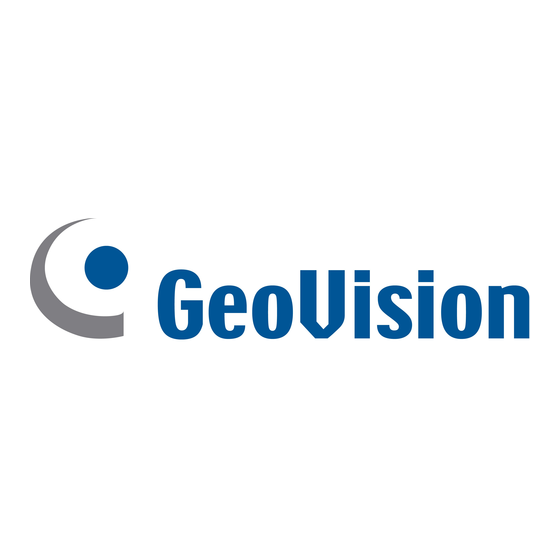
Table of Contents
Advertisement
Quick Links
Quick Start Guide
GV-Cloud VMS
Thank you for purchasing GV-Cloud VMS This guide is designed to assist the
new user in getting immediate results from the GV-Cloud VMS. For advanced
information on how to use the GV-Cloud VMS, please refer to GV-Cloud VMS
User's Manual.
© 2024 GeoVision Inc. All rights reserved.
CLOUDVMSV120-QG-B
Advertisement
Table of Contents

Summary of Contents for GeoVision GV-Cloud VMS
- Page 1 Quick Start Guide GV-Cloud VMS Thank you for purchasing GV-Cloud VMS This guide is designed to assist the new user in getting immediate results from the GV-Cloud VMS. For advanced information on how to use the GV-Cloud VMS, please refer to GV-Cloud VMS User's Manual.
- Page 2 GeoVision. Every effort has been made to ensure that the information in this manual is accurate. GeoVision, Inc. makes no expressed or implied warranty of any kind and assumes no responsibility for errors or omissions. No liability is assumed for incidental or consequential damages arising from the use of the information or products contained herein.
-
Page 3: Table Of Contents
Contents 1. Introduction ................ 1 1.1 Licenses ..................... 1 1.2 Compatible Browsers .................. 2 1.3 Compatible GeoVision Products ..............3 2. Getting Started ..............4 2.1 Login ......................4 2.2 Adding Licenses ..................5 2.3 Creating Hosts .................... 6 2.4 Connecting GV-VMS or GV-AI Guard ............7 2.5 Connecting GV-Cloud Bridge .............. -
Page 4: Introduction
1. Introduction Welcome to the GV-Cloud VMS Quick Start Guide. This quick guide will guide you through the basic settings of GV-Cloud VMS, including adding a license, creating a host and connecting a host to GV-Cloud VMS. For more details, see GV-Cloud VMS User’s Manual. -
Page 5: Compatible Browsers
1.2 Compatible Browsers The following browsers are compatible with GV-Cloud VMS. ⚫ Chrome ⚫ Firefox ⚫ Safari ⚫ Microsoft Edge Note: The WS player is not supported by Safari. -
Page 6: Compatible Geovision Products
Introduction 1.3 Compatible GeoVision Products ⚫ GV-VMS (surveillance software): V18.3.2 + Patch or later; V17.4.7 + Patch or later ⚫ GV-AI Guard (surveillance software): V2.1 or later ⚫ GV-Cloud Bridge (encoder): Firmware V1.03 or later ⚫ GV-Cloud Cam: GV-GBL4900, GBL4911, GDR4900, GEB4900, GEBF4911, GVD4910 ⚫... -
Page 7: Getting Started
2. Getting Started To get started, you must acquire a GV-Cloud VMS license and a series number from GeoVision. 2.1 Login 1. Log into the GV-Cloud portal: https://www.gvaicloud.com/ 2. Click Sign up. 3. Type the GV-Cloud user’s Name, E-mail, mobile phone number (optional), and Password. -
Page 8: Adding Licenses
4. To view details on a Plan you purchased, click it under the Subscription List. 5. After adding hosts to GV-Cloud VMS, you can return to the Subscription List page, and enable or disable any cameras using the License Cameras option of each Plan. -
Page 9: Creating Hosts
2.3 Creating Hosts You must create a Host for each GV-VMS, GV-AI Guard, or GV-Cloud Bridge that you want to connect to. To create a host on GV-Cloud VMS, follow the steps below. Select Hosts in the left menu, and click at the top right. -
Page 10: Connecting Gv-Vms Or Gv-Ai Guard
Getting Started 2.4 Connecting GV-VMS or GV-AI Guard Follow the steps below to connect GV-VMS or GV-AI Guard to GV-Cloud VMS for cloud central monitoring. Note: Events supported by GV-VMS / GV-AI Guard vary. The following instructions are exemplified from GV-VMS V18. - Page 11 In the left menu, click Live Streaming. Expand the host in the host list. Click a camera to see its live view. By adding a license, you can receive snapshots or back up video to GV-Cloud VMS. For details, see 2.2 Adding Licenses. Note: If the GV-Cloud VMS connection fails in GV-VMS / GV-AI Guard, check to see if WebCam Server and Mobile Service are enabled alongside Connect to GV-Cloud.
-
Page 12: Connecting Gv-Cloud Bridge
You can connect up to four ONVIF cameras, through GV-Cloud Bridge, to GV-Cloud VMS for cloud central monitoring. Note: To ensure a smooth playback on GV-Cloud VMS, it is suggested to connect a maximum of 2 cameras for the 4 MP license plan, 3 cameras for 2 MP license plan, and 4 cameras for 720p and SD license plan. - Page 13 In the left menu, click Live Streaming. Expand the host in the host list. Click a camera to see its live view. By adding a license, you can receive snapshots or back up video to GV-Cloud VMS. For details, see 2.2 Adding Licenses.
-
Page 14: Home Page
3. Home Page Name Function Click the GV-Cloud Apps icon to access Cloud VMS, VPN, eMap, Audit GV-Cloud Apps Log, and Account Management. Access these functions: Home, Hosts, Live Streaming, Playback, Left Menu Query Events, Share Links, Archives, and Groups. Display hosts and connection status. - Page 15 Display coming motion. ⚫ Use the Filter above the Host List to display the events of specific Event Monitor hosts. ⚫ Click an event to open the video window and view its snapshot, live view and playback. AI Event Switch Display coming AI events when enabled.














Need help?
Do you have a question about the GV-Cloud VMS and is the answer not in the manual?
Questions and answers